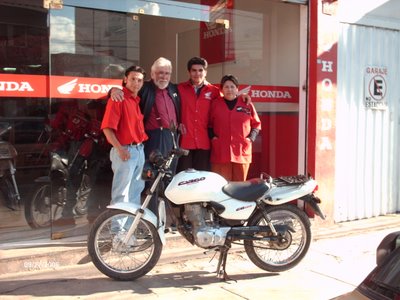SATURDAY, SEPTEMBER 30
Political correctness and the H quotient have been in play. The BBC’s correspondent described last week's strike of the southern provinces of Bolivia as a strike of white Bolivians against the indiginous population of the North. Odd, I find no mention on the BBC’s site of the miners’ blockade. Perhaps the correspondent is seeking to define the miners’ colour.
I have been in Cochabamba for two and a half days. I have walked the streets, sat at cafés, eaten in restaurants. Where are these pure bloods of European descent? This white majority of the BBC correspondent’s imagination?
My own perceptions are limited and probably equally erroneous. Cochabamba is a fun city. It is a city loved and cared for by its residents. Flowering trees line clean streets. After La Paz, you feel that you are in a different country. Here are a few quotations:
“There will be civil war.”
“What can you expect when the President is an Indian.”
“Better an intelligent crook than an honourable incompetent.”
“The Americans should do something.”
“The Americans are to blame, always interfering.”
The poor of La Paz love Morales.
So do Europe’s liberal intelligencia.
I am ignorant.
I have no facts.
I have no opinion.
septuagenarian odyssies - US/Mexican border to Tierra del Fuego, Tierra del Fuego to New York, long ride round India
Saturday, September 30, 2006
JED
SATURDAY, SEPTEMBER 30
I take lunch at the home of a Bolivian icon, a footballer, a goalkeeper. He is younger than I by a few years yet walks with a frame and is clumsy with his hands. “Cortisone,” he explains, “Playing when injured.”
We drink and talk while the TV displays extreme sports. I watch the crashes, kids bleeding, and come near to vomiting with fear for Jed, my youngest son. Jed, the mountain border, on first name terms with ambulance crews…
I take lunch at the home of a Bolivian icon, a footballer, a goalkeeper. He is younger than I by a few years yet walks with a frame and is clumsy with his hands. “Cortisone,” he explains, “Playing when injured.”
We drink and talk while the TV displays extreme sports. I watch the crashes, kids bleeding, and come near to vomiting with fear for Jed, my youngest son. Jed, the mountain border, on first name terms with ambulance crews…
CLASSIC BIKE CLUB

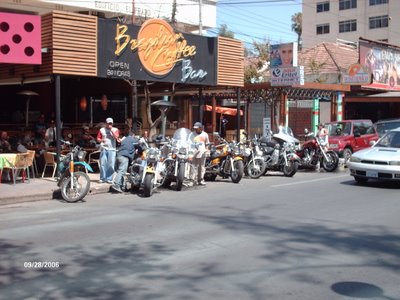

SATURDAY, SEPTEMBER 30
The sun shines. I sit at a café with members of Cochobamba’s Classic Bike Club. They insist I fetch my bike from the hotel garage. It is barely visible parked amongst its wealthy relatives, more a guinea pig than a Hog. These men are wealthy. The custom seats on their Harleys and massive Hondas cost more than my 125. We exchange tales of accidents; politics are off the menu. Frustrating, as I long to learn their opinions.
SUNSHINE

SATURDAY, SEPTEMBER 30
I sit in the sun and eat breakfast this morning at a sidewalk café. I am warm. Cochabamba is heaven. Rereading my Blogs of the past month or more, I realise that I have talked with few people. Opening conversations with strangers demands emotional energy. Cold is a sapper of energy. All those clothes form a barrier. Now, in the sun, I am brave. I talk after breakfast with an Argentinean architect, constructor of a cinema complex. Jewish. We talk of the conquest and the Jewish emigration from Spain to Latin America and of the Islamic influence on early Hispanic Colonial architecture and of the friendships and business friendships and alliances between Jewish and Arab immigrants in Argentina. The architect speaks of the Malvinas/Falklands war, of the young men whose lives were sacrificed to the demands of a drunk and to a woman’s need for a key to reelection.
HONDA
Friday, September 29, 2006
ALTITUDE
THURSDAY, SEPTEMBER 28
The road climbed beyond the blockade. Snow sprinkled the fell. The snowline lay well below the road. Cloud spat ice at my cheeks. My fingers froze. I didn’t give a damn. Honda and I have set a new personal record: fifteen thousand, four hundred feet (4700 meters). We have covered 420 Ks. Honda is resting at a very smart Honda Agency. I am in a hotel on the square. The owners of the hotel are Croatian and friends of Jorge Stambuk whom I met in Crinon, Colombia; he of the bio-diesel plant. The hotel bares that essential of a proper European family hotel: Madame sits behind the front desk and takes the money. I have a large room and large bathroom. The water is hot. The décor is 1930. My relationship to Jorge Stanbuk earns me a 20% discount. I am very comfortable.
The road climbed beyond the blockade. Snow sprinkled the fell. The snowline lay well below the road. Cloud spat ice at my cheeks. My fingers froze. I didn’t give a damn. Honda and I have set a new personal record: fifteen thousand, four hundred feet (4700 meters). We have covered 420 Ks. Honda is resting at a very smart Honda Agency. I am in a hotel on the square. The owners of the hotel are Croatian and friends of Jorge Stambuk whom I met in Crinon, Colombia; he of the bio-diesel plant. The hotel bares that essential of a proper European family hotel: Madame sits behind the front desk and takes the money. I have a large room and large bathroom. The water is hot. The décor is 1930. My relationship to Jorge Stanbuk earns me a 20% discount. I am very comfortable.
BLOCKADE
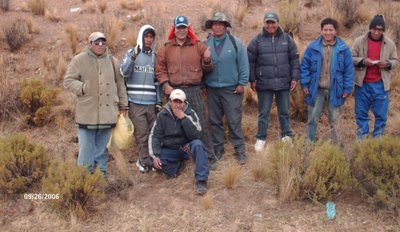
picket
THURSDAY, SEPTEMBER 28
Bolivia’s Morales is the President of the urban poor, the subsistence farmers and the manual workers. A magic wand should go with the job. It doesn’t. Morales is behind on his promises. His electorate are impatient. The miners have blockaded the road to Chocabamba. This is the third day of the blockade. Cars can manage a U turn. Trucks and busses are stuck. They are stuck in a double column twenty five Ks long. Local women have opened up roadside eateries. Bus passengers are dragging their gear in hope of a cab. I weave through to the rock barrier. A union meeting is breaking up. I boast that my eldest son is a union official. A group collects on a bank to have their photograph taken. A miner takes the camera and photographs me in the centre of the picket. Sadly he doesn’t push the button.
FREEZING
THURSDAY, SEPTEMBER 28
I waddle because I have dressed for the altitude. First the lower half: underpants, longjohns, two pairs of Chinos, dull-blue waterproof pants, red rugby socks, Church’ shoes. The top: two undershirts, one cord shirt, one sleeveless jumper, two long-sleeve jumpers, scarf, leather jacket, bright-blue waterproof jacket, wool gloves, leather gauntlets. Why am I freezing?
I waddle because I have dressed for the altitude. First the lower half: underpants, longjohns, two pairs of Chinos, dull-blue waterproof pants, red rugby socks, Church’ shoes. The top: two undershirts, one cord shirt, one sleeveless jumper, two long-sleeve jumpers, scarf, leather jacket, bright-blue waterproof jacket, wool gloves, leather gauntlets. Why am I freezing?
ADVENTURE
THURSDAY, SEPTEMBER 28
La Paz is in a hole. A road leads in. A road leads out. Escape is simple. I ride a hundred Ks before pulling in at a roadhouse. I park beside an outsize Bolivian-registered four by four fitted with all the Chelsea extras: spots on the roof, spots on the bull bar, winch, cowcatcher, rocket launcher, smoke grenades, ejector seats. The passenger-side smoked window slides down. A neat Bolivian blond asks where I’ve come from. “Mexico? On that bike? Magnificant.”
I, of course, looked humble.
“Where are you going? Argentina? Tierra del Fuego? Wow! Us too. That’s really great.”
The guy (ponytail) drums a finger on the padded leather steering wheel.
The blond takes the message. The smoked window slides up.
I dismount and waddle into the roadhouse.
La Paz is in a hole. A road leads in. A road leads out. Escape is simple. I ride a hundred Ks before pulling in at a roadhouse. I park beside an outsize Bolivian-registered four by four fitted with all the Chelsea extras: spots on the roof, spots on the bull bar, winch, cowcatcher, rocket launcher, smoke grenades, ejector seats. The passenger-side smoked window slides down. A neat Bolivian blond asks where I’ve come from. “Mexico? On that bike? Magnificant.”
I, of course, looked humble.
“Where are you going? Argentina? Tierra del Fuego? Wow! Us too. That’s really great.”
The guy (ponytail) drums a finger on the padded leather steering wheel.
The blond takes the message. The smoked window slides up.
I dismount and waddle into the roadhouse.
Wednesday, September 27, 2006
MUSEUMS & CHURCHES
WEDNESDAY, SEPTEMBER 29
I talked last night with a German, a Professor of philosophy. He has a new book finished and is taking a short break. Flying directly in to La Paz often brings on altitude sickness. The Professor is suffering – or I bored him to bed.
I was a good tourist all afternoon: two museums, two churches and a cathedral. The cathedral is gloomy. One of the museums is under repair. However the coffee in the coffee shop at the museum and church of San Francisco is the best I have drunk in more than a month. Today I visited more museums and am overdosed. The streets are steep and walking at over 4000 meters is tough on an old man. What did I see? More crude and unimaginative Inca gold, beautiful Tiwanachu ceramics. However – fifteen hundred years of working with clay, no potter’s wheel and so limited a palette.
I talked last night with a German, a Professor of philosophy. He has a new book finished and is taking a short break. Flying directly in to La Paz often brings on altitude sickness. The Professor is suffering – or I bored him to bed.
I was a good tourist all afternoon: two museums, two churches and a cathedral. The cathedral is gloomy. One of the museums is under repair. However the coffee in the coffee shop at the museum and church of San Francisco is the best I have drunk in more than a month. Today I visited more museums and am overdosed. The streets are steep and walking at over 4000 meters is tough on an old man. What did I see? More crude and unimaginative Inca gold, beautiful Tiwanachu ceramics. However – fifteen hundred years of working with clay, no potter’s wheel and so limited a palette.
HOSTAL REPUBLICA, LA PAZ
TUESDAY, SEPTEMBER 28
A viciously cold wind blows across the altiplano. For protection, the Spaniards built La Paz at the bottom of a gorge and when rush hour was three horses and a mule. Imagine pouring the traffic of a major city into so constricted a space. On a bike I advanced maybe a hundred metres in twenty minutes. I am staying two nights at the Hostal Republic two blocks off the Cathedral square. The hostal once was the private house of an ex President. An estate agent would describe it as a two-patio two-floor Spanish colonial. I have a single room on the upper floor overlooking the rear patio. The shower is reasonably hot and the towels are excellent. The building is romantic; $16 is a reasonable room rate. The help found a plank so I could ride the Honda up the steps. The patios are cobbled and the Honda is happy.
A viciously cold wind blows across the altiplano. For protection, the Spaniards built La Paz at the bottom of a gorge and when rush hour was three horses and a mule. Imagine pouring the traffic of a major city into so constricted a space. On a bike I advanced maybe a hundred metres in twenty minutes. I am staying two nights at the Hostal Republic two blocks off the Cathedral square. The hostal once was the private house of an ex President. An estate agent would describe it as a two-patio two-floor Spanish colonial. I have a single room on the upper floor overlooking the rear patio. The shower is reasonably hot and the towels are excellent. The building is romantic; $16 is a reasonable room rate. The help found a plank so I could ride the Honda up the steps. The patios are cobbled and the Honda is happy.
FERRY
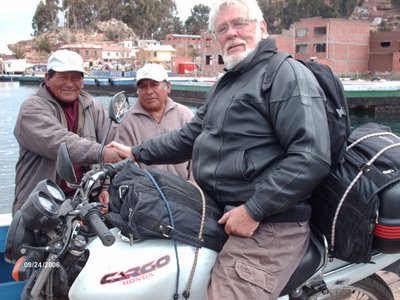
TUESDAY, SEPTEMBER 28
Wooden barges ferry trucks and busses across the straits. The barges are outboard powered and the passage is some four hundred meters. Ten or more of the barges wait in line. The crew won’t cross for a lone biker. A minibus drives onto the lead ferry and the captain waves me on board. The coxswain asks about my journey. He wants his photograph taken with me and the bike. One of his crewmen takes the picture. He is a novice with a camera and cuts off part of my head. The coxswain is happy with the result.
TWO INCHES
TUESDAY, SEPTEMBER 28
I eat a chicken roll and drink a large mug of hot black coffee in the cafeteria by the ferry quay. The woman serving me lost an eye; the socket has been sewn shut. She asks if I am sometimes frightened riding alone. I say that, No, I’m fine, just so long as I avoid the guide books.
A dozen women sell fruit and whatever from stalls outside the cafeteria. One of them demonstrates the size of whatever she is discussing by holding her two forefingers a couple of inches apart.
“Me,” I say from the doorway, pointing a finger at myself. “That’s not very kind.”
A few seconds pass in which the women don’t believe what they’ve heard. Then they break up. One has the laugh of an excited chicken. An old crone is doubled over: “Mala, mala, mala,” she shrieks.
I eat a chicken roll and drink a large mug of hot black coffee in the cafeteria by the ferry quay. The woman serving me lost an eye; the socket has been sewn shut. She asks if I am sometimes frightened riding alone. I say that, No, I’m fine, just so long as I avoid the guide books.
A dozen women sell fruit and whatever from stalls outside the cafeteria. One of them demonstrates the size of whatever she is discussing by holding her two forefingers a couple of inches apart.
“Me,” I say from the doorway, pointing a finger at myself. “That’s not very kind.”
A few seconds pass in which the women don’t believe what they’ve heard. Then they break up. One has the laugh of an excited chicken. An old crone is doubled over: “Mala, mala, mala,” she shrieks.
TITICACA
TUESDAY, SEPTEMBER 28
The road follows a high contour above Lake Titicaca. Thick rain-clouds to the east die the waters wine dark; a lone white motor launch draws a white trail. West is sunshine and the water is brilliant blue. My guidebook reports that the lake is mystical, that the terraces on the peninsular are Inca and the La Paz has the best market for buying ingredients for witchcraft. My guidebook also reported that the customs officers were crooks and warned that I would be raped, strangle mugged, abducted by guerrillas and shot by paramilitaries. Forget the book and the mystic and the Incas. Stick with the facts: the fells are beautiful and the lake is beautiful. I am immensely privileged in riding these hills on such a glorious morning.
The road follows a high contour above Lake Titicaca. Thick rain-clouds to the east die the waters wine dark; a lone white motor launch draws a white trail. West is sunshine and the water is brilliant blue. My guidebook reports that the lake is mystical, that the terraces on the peninsular are Inca and the La Paz has the best market for buying ingredients for witchcraft. My guidebook also reported that the customs officers were crooks and warned that I would be raped, strangle mugged, abducted by guerrillas and shot by paramilitaries. Forget the book and the mystic and the Incas. Stick with the facts: the fells are beautiful and the lake is beautiful. I am immensely privileged in riding these hills on such a glorious morning.
FEMINISM
TUESDAY, SEPTEMBER 28
Cocabamba is on a peninsular. The peninsular is mountainous and projects from Peruvian territory so it is a de facto island. You take a ferry to Bolivia proper. Cocabamaba is 25 Ks from the ferry port. The road climbs to 4100 meters. Early morning is cold – especially for a biker. The road is under repair. Men lug stones. They don’t wear gloves. Nor do the women who man the wheelbarrows. The hems of the women’s pettycoats and skirts show beneath yellow slickers. I consider myself a feminist. This wasn’t the equality I envisaged.
Cocabamba is on a peninsular. The peninsular is mountainous and projects from Peruvian territory so it is a de facto island. You take a ferry to Bolivia proper. Cocabamaba is 25 Ks from the ferry port. The road climbs to 4100 meters. Early morning is cold – especially for a biker. The road is under repair. Men lug stones. They don’t wear gloves. Nor do the women who man the wheelbarrows. The hems of the women’s pettycoats and skirts show beneath yellow slickers. I consider myself a feminist. This wasn’t the equality I envisaged.
COCABAMBA

MONDAY, SEPTEMBER 26
Cocabamba is built on the saddle between two hills. The town slopes steeply down to the shore and reminds me of a Mediteranean fishing village come tourist resort. The townsfolk seem friendlier, happier and more fun-loving than Peruvians. They may eat tourists, but they exercise charm; Peruvians prefer the bludgeon. A big white Cathedral dominates the town. The tiled domes of the towers and the vast courtyard should belong to a mosque. The simplicity of the Cathedral’s interior is equally Arabic.
I booked into the Colonial, big room with lake view and hot shower. The bedside lamp didn’t work. I switched rooms. The shower didn’t work. However the beds were great and a room rate of $5 that includes Continental breakfast isn’t exorbitant. A wet Brit on Gap Year confronted me on the stairs. He had been swimming in the lake. He claimed that the water was shallow and therefor warm. I was shivering from a bike ride. A second young Brit and two young North Americans made a foursome in the hotel garden. I would have enjoyed hearing their stories. Unfortunately, I carry a fatal disease, Age, and they chose the table furthest from where I sat. Sad.
Tuesday, September 26, 2006
HI, BOLIVIA
MONDAY, SEPTEMBER 25
The vicious corrupt Bolivian customs officer is a gardener. He is dressed in a wool jumper and is pushing a wheelbarrow. He directs me to Immigration where I fill in the standard tourist fiche (five minutes). I return to the Customs office. The customs officer parks his wheelbarrow and we complete a transit permit for the Honda. Though patient, he is keen to get back to his barrow. He stamps and signs the permit and points me to the transit police for a counter signature. Total time at the Bolivian border? Barely fifteen minutes. For this I have worried. I suspect that the writer of my guidebook is an irritating and arrogant young man – a type officials hate on sight. Or perhaps I have been lucky. Perhaps my age helps. They imagine my dying on them and the paper work and they think, Quick! move the old fool on.
The vicious corrupt Bolivian customs officer is a gardener. He is dressed in a wool jumper and is pushing a wheelbarrow. He directs me to Immigration where I fill in the standard tourist fiche (five minutes). I return to the Customs office. The customs officer parks his wheelbarrow and we complete a transit permit for the Honda. Though patient, he is keen to get back to his barrow. He stamps and signs the permit and points me to the transit police for a counter signature. Total time at the Bolivian border? Barely fifteen minutes. For this I have worried. I suspect that the writer of my guidebook is an irritating and arrogant young man – a type officials hate on sight. Or perhaps I have been lucky. Perhaps my age helps. They imagine my dying on them and the paper work and they think, Quick! move the old fool on.
ADIEU PERU
MONDAY, SEPTEMBER 25
Peruvian Immigration takes all of two minutes. Customs is a problem. Our friendly and helpful customs officer from the frontier with Ecuador completed the exit part of the Honda’s transit permit rather than the entry.
“A tall man, talks a lot,” suggests the present officer as he scans the signature.
“Yes,” I say. “A very amiable man.”
“Very amiable,” agrees his fellow official. “Amiable is all he is. I’ve served with him.”
I wait while he writes an explanation of the error on pink paper. I add my signature. He affixes the report to the transit permit. We shake hands. I am out of Peru.
Peruvian Immigration takes all of two minutes. Customs is a problem. Our friendly and helpful customs officer from the frontier with Ecuador completed the exit part of the Honda’s transit permit rather than the entry.
“A tall man, talks a lot,” suggests the present officer as he scans the signature.
“Yes,” I say. “A very amiable man.”
“Very amiable,” agrees his fellow official. “Amiable is all he is. I’ve served with him.”
I wait while he writes an explanation of the error on pink paper. I add my signature. He affixes the report to the transit permit. We shake hands. I am out of Peru.
VICTIM
MONDAY, SEPTEMBER 25
The writer of my guidebook warns of corrupt practices at the Bolivian frontier with Peru. The writer mentions motorcyclists as victims. Yeah, have a nice day. The road follows the lake shore. I see thirty or more men seated on benches at the rear of an adobe house. The men are similarly dressed in black suits and black fedoras. They are silent and solemn. This must be a wake. They should take lessons from the Irish.
The road climbs behind a hill. Concrete steps mount the hill. Each step represents a Station of the Cross. Two tall radio masts dominate the hilltop. The shrine is insignificant.
I pause and look back across a bay. The water reflects the deep blue of the sky. A thousand mirrors gleam on the far shore - tin roofs catching the sunlight.
I note two rough-coated white donkeys on a pale beach.
And I worry. Ten Ks to the frontier. Here comes the victim.
The writer of my guidebook warns of corrupt practices at the Bolivian frontier with Peru. The writer mentions motorcyclists as victims. Yeah, have a nice day. The road follows the lake shore. I see thirty or more men seated on benches at the rear of an adobe house. The men are similarly dressed in black suits and black fedoras. They are silent and solemn. This must be a wake. They should take lessons from the Irish.
The road climbs behind a hill. Concrete steps mount the hill. Each step represents a Station of the Cross. Two tall radio masts dominate the hilltop. The shrine is insignificant.
I pause and look back across a bay. The water reflects the deep blue of the sky. A thousand mirrors gleam on the far shore - tin roofs catching the sunlight.
I note two rough-coated white donkeys on a pale beach.
And I worry. Ten Ks to the frontier. Here comes the victim.
FUNERAL PARLOR
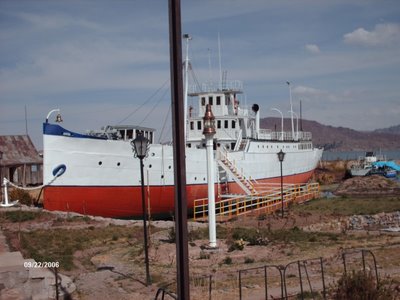
made in britain 2nd steamship brought to Puna
SUNDAY, SEPTEMBER 24
I count eighteen restaurants on Puna’s pedestrian street. All but Rica’s Café are geared to tourists. Look in through any window, there we sit, we, the rich (by Peruvian standards). The restaurants employ hustlers. The altitude is above three thousand meters and the hustlers wrap up in ankle-length overcoats and matching mufflers. Charcoal grey is an unfortunate colour. Look at the menu, what do you expect? Price list from a funeral parlour. Watch out for the extras…
CULTURAL COLONIALISM
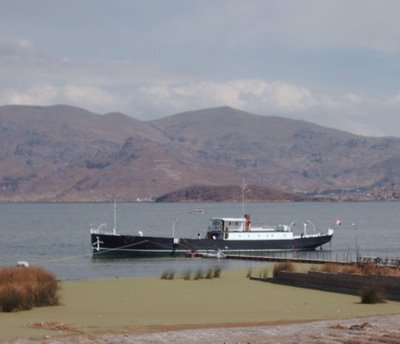
made in britain
carried in pieces
up to Puna on mules
SUNDAY, SEPTEMBER 24
Cultural Colonialism hits randomly. I watch a family of six Peruvians in a small restaurant. A young woman angles her head and flashes a smile at her father. She wants something. The flirtation is pure Hollywood. On the pedestrian street, a tall, exceptionally dark-skinned young man is unique amongst his Puna contemporaries in wearing HipHop.
Subscribe to:
Comments (Atom)
